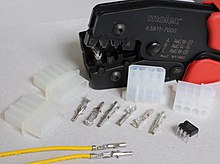This article needs additional citations for verification. (December 2014) |
 AMP Mate-n-Lok 1-480424-0 Power connector (female pins, male connector) | |||
| Type | Electrical power connector | ||
|---|---|---|---|
| Production history | |||
| Manufacturer | AMP | ||
| Produced | 1963 | ||
| General specifications | |||
| Width | 21 mm (female), 23 mm (male) | ||
| Height | 6 mm (female), 8 mm (male) | ||
| Pins | 4 | ||
| Electrical | |||
| Signal | Yes | ||
| Max. voltage | 12 V | ||
| Max. current | 11 A/pin (18AWG w/30 °C rise) | ||
| Pinout | |||
 | |||
| Male pins (female connector) | |||
| Pin | Color | Type | |
| Pin 1 | Yellow | +12 V | |
| Pin 2 | Black | Ground | |
| Pin 3 | Black | Ground | |
| Pin 4 | Red | +5 V | |
| 18 AWG, or 0.823 mm2 wire is typically used. | |||




A Molex connector is a two-piece pin-and-socket interconnection which became an early electronic standard. Developed by Molex Connector Company in the late 1950s, the design features cylindrical spring-metal pins that fit into cylindrical spring-metal sockets, both held in a rectangular matrix in a nylon shell.
AMP (now TE Connectivity) introduced the Mate-n-Lok connector in October 1963, which was similar to Molex's patented design but not compatible. It featured improvements such as being keyed to prevent incorrect insertion. The Mate-n-Lok connector design led to several connector types that have become established for connecting power in desktop PCs because of their simplicity, reliability, flexibility, and low cost, and is more widely known as a "Molex connector" despite not being from the Molex company.